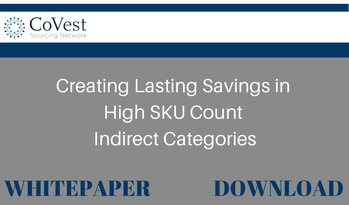
While Request for Proposals can be a great way of understanding how a supplier intends on handling your company's challenges, it is just not worth the effort for some categories. A procurement organization has a lot on their plate as it is. From finding the best-in-class prices to developing better supplier partners. It makes little sense to use loads of resources on an RFP for many non-strategic, basic categories, when this time could be better spent on high value strategic categories. So stop wasting your time doing RFPs on commodities and services that could be better leveraged and managed by a Group Purchasing Organization (GPO). This includes categories like office supplies, office equipment, temporary labor, industrial supplies and pharmacy benefits.
While it may seem as if your company is bringing in savings from a typical three year RFP cycle, that is not entirely the case. Let's say there is a company with a $1.5 million spend who decides to source their office supplies category internally. In the initial sourcing process they find a savings of 15% and decide to sign a three year contract. At the end of the three years, they do another RFP and find another 15% in savings. I bet you're wondering, "How?" When we see everything else going up in cost, it's natural to wonder how office supplies can be going down by 15% every three years.
The truth is you are not finding an additional 15% savings after three years. What you are finding is a 15% savings on the items probably not included in your original proposal. The supplier has been benefiting from the churn of high volume items, whose prices were negotiated in the RFP, that are replaced with items priced close to list or at a small discount. The new RFP is just capturing these lost opportunities, not really saving money.
Using a GPO to source categories has a number of advantages:
- It brings savings on line faster. A typical RFP process can take from three to six months versus less than a month when utilizing a GPO deal.
- It frees up valuable purchasing resources that can be redeveloped on larger more strategic categories.
- There is no cost for using a GPO. It can cost over $50,000 of internal staff cost, and ten times that or more if consultants are engaged, to source a category.
- A GPO pricing leverages the spend of dozens of member companies and can provide pricing that is typically 10% to 20% better than an individual company can achieve on its own - even for multi-billion dollar revenue companies.
- A GPO is constantly refreshing its pricing and avoids the lost opportunity discussed in the previous paragraph.
- A GPO can provide on-going price auditing and saving tracking that can be applied to your organizations goals.
More than 30 large corporations rely on CoVest to drive down costs by leveraging the spend of member companies, providing best-in-class pricing and value. CoVest's current members’ annual revenue totals more than $350 billion and averages more than $10 billion. Expansion of indirect categories is driven by the needs of member companies and decided at periodic member meetings. No upfront costs, long-term commitments or investments are required to join the network.





